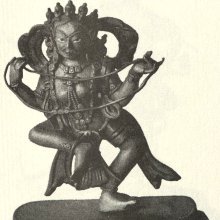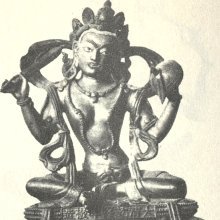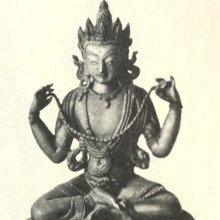Malya, Mālya: 26 definitions
Introduction:
Malya means something in Buddhism, Pali, Hinduism, Sanskrit, Marathi, Hindi, biology. If you want to know the exact meaning, history, etymology or English translation of this term then check out the descriptions on this page. Add your comment or reference to a book if you want to contribute to this summary article.
Alternative spellings of this word include Maly.
Images (photo gallery)
In Hinduism
Natyashastra (theatrics and dramaturgy)
Source: Wisdom Library: Nāṭya-śāstraMālya (माल्य) refers to “flower-garlands” and is one of the four types of alaṃkāra, or “decorations”, according to Nāṭyaśāstra chapter 23. Alaṃkāra represents one of the categories of nepathya, or “costumes and make-up”, the perfection of which forms the main concern of the Āhāryābhinaya, or “extraneous representation”, a critical component for a successful dramatic play.
There are five types of flower-garlands (mālya):
- veṣṭita (encircling),
- vitata (spread-up),
- saṃghātya (grouped),
- granthima (knotted),
- pralambita (hung-down).

Natyashastra (नाट्यशास्त्र, nāṭyaśāstra) refers to both the ancient Indian tradition (shastra) of performing arts, (natya—theatrics, drama, dance, music), as well as the name of a Sanskrit work dealing with these subjects. It also teaches the rules for composing Dramatic plays (nataka), construction and performance of Theater, and Poetic works (kavya).
Vaishnavism (Vaishava dharma)
Source: Pure Bhakti: Arcana-dipika - 3rd EditionMālya (माल्य) refers to a “garland” (i.e., a garland of fragrant flowers) and represents one of the various articles offered during worship, according to the Arcana-dīpikā (manual on deity worship), while explaining procedures performed in the morning.—According to time and place, sixteen [viz., mālya], twelve, ten or five articles can be employed in the worship of Śrī Bhagavān.

Vaishnava (वैष्णव, vaiṣṇava) or vaishnavism (vaiṣṇavism) represents a tradition of Hinduism worshipping Vishnu as the supreme Lord. Similar to the Shaktism and Shaivism traditions, Vaishnavism also developed as an individual movement, famous for its exposition of the dashavatara (‘ten avatars of Vishnu’).
Shaivism (Shaiva philosophy)
Source: Brill: Śaivism and the Tantric TraditionsMālya (माल्य) (Cf. Sragvin) refers to “garlands”, according to the 9th-century Sarvajñānottaratantra chapter 18.—Accordingly, “Next, I shall teach the best observance among observances, which is known as the Śiva-vrata and which is revered by Asuras and Gods alike. Pure pale ash [should be used, and] white dress and unguents; he should wear a white sacred thread and be adorned by a chignon of matted locks. He should be equipped with all [suitable] ornaments, [and] adorned with white garlands (śukla-mālya-vibhūṣita); he should consume [only the pure ritual gruel-offering known as] caru; he should observe the chaste conduct of a student; he should venerate Śiva, the fire and his Guru. [...]”.

Shaiva (शैव, śaiva) or Shaivism (śaivism) represents a tradition of Hinduism worshiping Shiva as the supreme being. Closely related to Shaktism, Shaiva literature includes a range of scriptures, including Tantras, while the root of this tradition may be traced back to the ancient Vedas.
Purana and Itihasa (epic history)
Source: archive.org: Shiva Purana - English TranslationMālya (माल्य) refers to “garlands” (e.g., of jasmine flowers), according to the Śivapurāṇa 2.3.38 (“Description of the dais or maṇḍapa”).—Accordingly, as Himavat prepared the wedding of Menā and Śiva: “[...] Festoons with garlands of jasmine flowers (mālatī-mālya-saṃyukta) shone, everywhere. Other articles of auspicious portent were fixed in every quarter. These and other things were carried out by Himavat for the sake of his daughter. Every activity was supervised by Garga of great ability. Everything auspicious worth mentioning found a place there. He called Viśvakarman and requested him to erect a large and spacious dais beautiful with side rostrums, altars etc. [...]”.

The Purana (पुराण, purāṇas) refers to Sanskrit literature preserving ancient India’s vast cultural history, including historical legends, religious ceremonies, various arts and sciences. The eighteen mahapuranas total over 400,000 shlokas (metrical couplets) and date to at least several centuries BCE.
In Buddhism
Tibetan Buddhism (Vajrayana or tantric Buddhism)
Source: Wisdom Library: Tibetan Buddhist Teachers, Deities and other Spiritual beingsMālyā (माल्या) refers to one of the “Forty-two Peaceful Deities” (Tibetan: zhi ba'i lha zhe gnyis) according to various sources such as the Guhyagarbha Tantra and the Tibetan Book of the Dead.—They feature in Tantric teachings and practices which focus on purifying elements of the body and mind. These deities [e.g., Mālyā] form part part of the the Hundred Peaceful and Wrathful Deities who manifest to a deceased person following the dissolution of the body and consciousness whilst they are in the intermediate state (bardo) between death and rebirth.
Mālyā or Mālā is also known in Tibetan as: Trengwama [phreng ba ma]. She is the consort of Ākāśagarbha and part of the “Eight Female Bodhisattvas”.
Source: archive.org: The Indian Buddhist IconographyMālyā (माल्या) or Mālā refers one of four dance-deities, commonly depicted in Buddhist Iconography, and mentioned in the 11th-century Niṣpannayogāvalī of Mahāpaṇḍita Abhayākara.—Her Colour is red; her Symbol is the garland; she has two arms.—All these four deities (viz., Mālyā) are popular in the Vajrayāna pantheon and are described times without number both in the Sādhanamālā as well as in the Niṣpannayogāvalī.
Mālyā is described in the Niṣpannayogāvalī (pañcaḍāka-maṇḍala) as follows:—
“Mālyā (Mālā) is of red colour and holds in her two hands the garland of jewels”.
[All these dance-deities are violent in character with garland of severed heads, and dance in pratyālīḍha. They show the tarjanī against the chest as the common gesture.]

Tibetan Buddhism includes schools such as Nyingma, Kadampa, Kagyu and Gelug. Their primary canon of literature is divided in two broad categories: The Kangyur, which consists of Buddha’s words, and the Tengyur, which includes commentaries from various sources. Esotericism and tantra techniques (vajrayāna) are collected indepently.
Mahayana (major branch of Buddhism)
Source: academia.edu: A Study and Translation of the GaganagañjaparipṛcchāMālya (माल्य) refers to “(showering) garlands”, according to the Gaganagañjaparipṛcchā: the eighth chapter of the Mahāsaṃnipāta (a collection of Mahāyāna Buddhist Sūtras).—Accordingly, “[...] Then, by the unconditioned magical power of manifestation, by the miraculous performances (vikrīḍita) of the Buddha [Ekaratnavyūha], [Gaganagañja with the other Bodhisattvas] teleported from the Mahāvyūha universe to the Sahā universe, in one moment of thought, and sat down there. They showered flowers, garlands (puṣpa-mālya), powders, perfumes, unguents, parasols, banners, flags from the Mahāvyūha universe pouring down as rain”
Source: De Gruyter: A Buddhist Ritual Manual on AgricultureMālya (माल्य) refers to “garlands” (suitable for worship), according to the Vajratuṇḍasamayakalparāja, an ancient Buddhist ritual manual on agriculture from the 5th-century (or earlier), containing various instructions for the Sangha to provide agriculture-related services to laypeople including rain-making, weather control and crop protection.—Accordingly, [after the Bhagavān entered the assembly of Nāgas], “Then the great Nāga king Samantākāracchatrākaraparikara arose from his seat, arranged his outer robe on one shoulder, placed his right knee on the ground, approached the Bhagavān and, having bowed down at his feet, circumambulated him three times, and worshipped the Bhagavān with different flowers, fragrances, garlands [e.g., nānā-mālya], ointments, ornaments and cloths. Having worshipped him, he sat down in front of him”.

Mahayana (महायान, mahāyāna) is a major branch of Buddhism focusing on the path of a Bodhisattva (spiritual aspirants/ enlightened beings). Extant literature is vast and primarely composed in the Sanskrit language. There are many sūtras of which some of the earliest are the various Prajñāpāramitā sūtras.
Biology (plants and animals)
Source: Google Books: CRC World Dictionary (Regional names)Malya in India is the name of a plant defined with Trigonella balansae in various botanical sources. This page contains potential references in Ayurveda, modern medicine, and other folk traditions or local practices It has the synonym Trifolium corniculatum L. (among others).
Example references for further research on medicinal uses or toxicity (see latin names for full list):
· Recent Res. Pl. Sci.. (1979)
· Diagnoses plantarum orientalium novarum (1856)
· Species Plantarum (1753)
· Systema Naturae, ed. 10
· Anz. Österr. Akad. Wiss., Math.-Naturwiss. Kl. (1956)
If you are looking for specific details regarding Malya, for example pregnancy safety, diet and recipes, health benefits, extract dosage, chemical composition, side effects, have a look at these references.

This sections includes definitions from the five kingdoms of living things: Animals, Plants, Fungi, Protists and Monera. It will include both the official binomial nomenclature (scientific names usually in Latin) as well as regional spellings and variants.
Languages of India and abroad
Pali-English dictionary
Source: BuddhaSasana: Concise Pali-English Dictionarymālya : (nt.) a garland.
Source: Sutta: The Pali Text Society's Pali-English DictionaryMālya, see malya. (Page 531)
— or —
Malya, (nt.) (for *mālya, fr. māla) flower, garland of flowers Vv 11 (-dhara); 21; J. V, 188 (puppha°), 420. ‹-› The reading at Pv III, 33 (pahūta°, adj. having many rows of flowers) is mālya. (Page 525)

Pali is the language of the Tipiṭaka, which is the sacred canon of Theravāda Buddhism and contains much of the Buddha’s speech. Closeley related to Sanskrit, both languages are used interchangeably between religions.
Marathi-English dictionary
Source: DDSA: The Molesworth Marathi and English Dictionarymalyā (मल्या).—m The name of a little freshwater-fish.
--- OR ---
maḷyā (मळ्या).—a Reddishly brown, dun. A color of cattle &c.
--- OR ---
maḷyā (मळ्या).—m The name of a fish.
--- OR ---
mālya (माल्य).—n S A flower. 2 A garland, wreath, chaplet.
Source: DDSA: The Aryabhusan school dictionary, Marathi-Englishmālya (माल्य).—n A flower. A garland.
Marathi is an Indo-European language having over 70 million native speakers people in (predominantly) Maharashtra India. Marathi, like many other Indo-Aryan languages, evolved from early forms of Prakrit, which itself is a subset of Sanskrit, one of the most ancient languages of the world.
Sanskrit dictionary
Source: DDSA: The practical Sanskrit-English dictionaryMālya (माल्य).—a. [mālāyai hitaṃ yat] Proper for or relating to a garland.
-lyam 1 A garland, wreath; माल्येन तां निर्वचनं जघान (mālyena tāṃ nirvacanaṃ jaghāna) Kumārasambhava 7.19; Kirātārjunīya 1.21.
2) A flower; दिव्य- माल्याम्बरधरम् (divya- mālyāmbaradharam) Bhagavadgītā (Bombay) 11.11; Manusmṛti 4.72.
3) A chaplet or garland worn on the head.
Source: Cologne Digital Sanskrit Dictionaries: Edgerton Buddhist Hybrid Sanskrit DictionaryMālya (माल्य).—nt. (in this sense Sanskrit Lex. and once in late Sanskrit, Schmidt, Nachträge; so also, allegedly, Pali malya, mālya, and mālā), flower: Mahāvastu i.249.12 (prose) imāni… sthalajajalajāni mālyāni…(list follows, atimuktaka- campaka- etc.); ii.449.2.
--- OR ---
Mālyā (माल्या).—name of a goddess or yoginī (Garland personified): Sādhanamālā 157.12; 312.3; in 324.6 Mālā, q.v.
Source: Cologne Digital Sanskrit Dictionaries: Shabda-Sagara Sanskrit-English DictionaryMālya (माल्य).—mfn.
(-lyaḥ-lyā-lyaṃ) Proper or fit for a garland, &c. n.
(-lyaṃ) 1. A flower. 2. A garland, a wreath. 3. A chaplet, a garland for the forehead. f.
(-lyā) A sort of grass, (Trigonella corniculata.) E. mālā a garland, and yat aff.
Source: Cologne Digital Sanskrit Dictionaries: Benfey Sanskrit-English DictionaryMālya (माल्य).—i. e. mālā + ya, I. adj. Fit for a garland. Ii. n. 1. A flower, [Johnson's Selections from the Mahābhārata.] 40, 38. 2. A garland, [Pañcatantra] 199, 19. 3. A chaplet, [Mānavadharmaśāstra] 2, 177.
Source: Cologne Digital Sanskrit Dictionaries: Cappeller Sanskrit-English DictionaryMālya (माल्य).—[neuter] wreath, crown; poss. vant, [masculine] also [Name] of a Rākṣasa, a mountain, etc.
Source: Cologne Digital Sanskrit Dictionaries: Monier-Williams Sanskrit-English Dictionary1) Mālya (माल्य):—[from māla] a m. [patronymic] [Pañcaviṃśa-brāhmaṇa] (also [plural] [Saṃskārakaustubha])
2) Mālyā (माल्या):—[from mālya > māla] f. Trigonella Corniculata, [cf. Lexicographers, esp. such as amarasiṃha, halāyudha, hemacandra, etc.]
3) Mālya (माल्य):—[from māla] n. a wreath, garland, chaplet, [Gṛhya-sūtra and śrauta-sūtra; Upaniṣad; Manu-smṛti] etc.
4) [v.s. ...] a flower, [cf. Lexicographers, esp. such as amarasiṃha, halāyudha, hemacandra, etc.]
5) [v.s. ...] mfn. relating to a garland, [Horace H. Wilson]
6) b etc. See [column]1.
Source: Cologne Digital Sanskrit Dictionaries: Yates Sanskrit-English DictionaryMālya (माल्य):—(lyaṃ) 1. n. A flower; a garland. f. Sort of grass. a. Fit for a garland.
Source: DDSA: Paia-sadda-mahannavo; a comprehensive Prakrit Hindi dictionary (S)Mālya (माल्य) in the Sanskrit language is related to the Prakrit word: Malla.
[Sanskrit to German]
Sanskrit, also spelled संस्कृतम् (saṃskṛtam), is an ancient language of India commonly seen as the grandmother of the Indo-European language family (even English!). Closely allied with Prakrit and Pali, Sanskrit is more exhaustive in both grammar and terms and has the most extensive collection of literature in the world, greatly surpassing its sister-languages Greek and Latin.
Hindi dictionary
Source: DDSA: A practical Hindi-English dictionaryMālya (माल्य) [Also spelled maly]:—(nm) a garland; ~[lyārpaṇa] offering a garland.
...
Kannada-English dictionary
Source: Alar: Kannada-English corpusMālya (ಮಾಲ್ಯ):—
1) [noun] a string or garland of flowers.
2) [noun] (jain.) a mythical tree that would yield garlands, one wished for.
3) [noun] the plant Trigonella corniculata of Papilionaceae family.
Kannada is a Dravidian language (as opposed to the Indo-European language family) mainly spoken in the southwestern region of India.
Nepali dictionary
Source: unoes: Nepali-English DictionaryMālya (माल्य):—n. 1. a garland; wreath; 2. a necklace; 3. a flower;
Nepali is the primary language of the Nepalese people counting almost 20 million native speakers. The country of Nepal is situated in the Himalaya mountain range to the north of India.
See also (Relevant definitions)
Partial matches: Nya, Maala, Mala.
Starts with (+9): Malyachal, Malyacitra, Malyadaman, Malyadhana, Malyadhara, Malyadharaya, Malyadvesha, Malyagahum, Malyagandha, Malyagrathana, Malyagunay, Malyagunaya, Malyajivaka, Malyajivin, Malyakrit, Malyala, Malyalam, Malyamahija, Malyanga, Malyanil.
Query error!
Full-text (+71): Nirmalya, Malyapushpa, Malyavat, Nairmalya, Gandhamalya, Malyapindaka, Malyavritti, Malyajivaka, Malyapushpika, Malyapana, Samalya, Raktamalya, Malyagrathana, Malyadaman, Kalimalya, Malyagunaya, Nivapamalya, Citramalya, Sumalya, Divyamalya.
Relevant text
Search found 51 books and stories containing Malya, Mala-nya, Mala-ṇya, Mala-nya, Māla-ṇya, Mala-nya, Mālā-ṇya, Mālya, Malyā, Maḷyā, Mālyā; (plurals include: Malyas, nyas, ṇyas, Mālyas, Malyās, Maḷyās, Mālyās). You can also click to the full overview containing English textual excerpts. Below are direct links for the most relevant articles:
Amarakoshodghatana of Kshirasvamin (study) (by A. Yamuna Devi)
Daily Life (2): Dress and Ornaments < [Chapter 3 - Social Aspects]
Bhakti-rasamrta-sindhu (by Śrīla Rūpa Gosvāmī)
Verse 2.4.133 < [Part 4 - Transient Ecstatic Disturbances (vyābhicāri-bhāva)]
Verse 3.3.66 < [Part 3 - Fraternal Devotion (sakhya-rasa)]
Verse 1.2.163 < [Part 2 - Devotional Service in Practice (sādhana-bhakti)]
Notices of Sanskrit Manuscripts (by Rajendralala Mitra)
Vasudevahindi (cultural history) (by A. P. Jamkhedkar)
34. Ornaments, Dress and Decorations (in ancient India) < [Chapter 3 - Social Conditions]
Guhyagarbha Tantra (with Commentary) (by Gyurme Dorje)
Text 1.10 (Commentary) < [Chapter 1 (text and commentary)]
Text 4.20 (Commentary) < [Chapter 4 (text and commentary)]
Text 7.4 (Commentary) < [Chapter 7 (text and commentary)]
Garga Samhita (English) (by Danavir Goswami)
Verses 6.5.23-24 < [Chapter 5 - The Kidnapping of Śrī Rukmiṇī]
Related products



